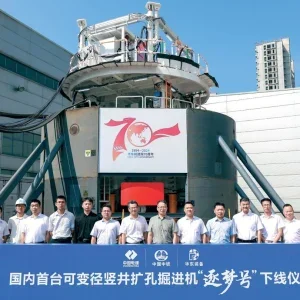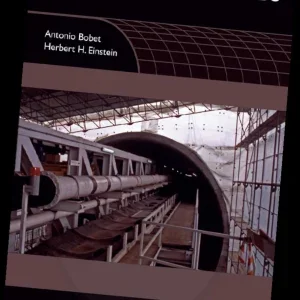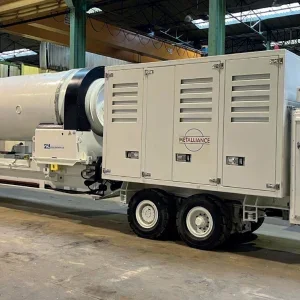During the construction of tunnels, the unexpected can easily occur and frequently does. Many projects throughout history bear testament to this statement. Traditional tunnelling methods, such as drill and blast, are flexible in their operational procedures and allow the introduction of additional measures, when necessary, to deal with unexpected circumstances. When more modern and sophisticated mechanised tunnelling techniques are used, in particular full-face tunnel boring machines, they are usually designed and tailored to suit the foreseen geological conditions. Nevertheless, they must still be capable of handling any conditions that occur.
Principals of the new strategy
Experience has shown that the difficulties and expense associated with modifications mid-drive, have resulted in the necessity to coordinate the planning and execution of the whole tunnelling process. This means considering the planning of the construction process, the concept of the machine design and the operating techniques together at the planning stage. Thus the interaction of man, method and machine are all taken into account at the outset. The strategy is based on the following principal stages, listed below. At each stage the design of the equipment, the process and its use must be considered together, in relation to both the expected conditions and any possible unexpected situations that might be encountered.
Stage 1: Basic planning
The complete tunnelling project must be considered at the initial design stage and then detail designs drawn up. These should include plans for the construction method and also for the concept design of the tunnelling machine. When complete it then becomes the “reference design”.
Stage 2: Risk and hazard analysis
To be effective the risk analysis must consider all possible hazards that the machine may encounter. These may be geological, created by the tunnelling process or caused by the machine. The analysis must be executed during the design phase before the start of machine construction. In the past such an analysis has often been carried out, but out only when problems are met. By then it is too late to make fundamental changes to the design. The main questions that must be addressed within the risk analysis are: “What is possible during the tunnelling process and what problems may occur?” Some typical examples of questions that might be addressed are:
For geology and hydrology
For environment
For TBM operation
The above questions are only typical. The list should be exhaustive, considering all the details of the project. The solutions to the problems highlighted by these questions must then be included in the scope of supply, or specification of the TBM to be used.
Stage 3: Scope of supply
The objective of the scope of supply is to define the requirement for all the different operating modes as early as possible in the design phase. These include the excavation, ring building and grouting phase of the normal boring operation, as well as conditions associated with face inspections and cutter changes, and any techniques used to deal with other possible hazards (e.g. probing or forward grouting).
It is necessary to define and find solutions for all these situations, thus specifying the design of the TBM and the tunnelling process. It is only in this way that subsequent problems, component failures and consequent damage to the surrounding environment can be avoided. The scope of supply comprises a list of TBM capabilities and performance requirements (i.e. a specification) including the methods by which these will be achieved (Figure 1). The list should provide specification criteria (and their solutions) that result from considering:
Stage 4: Acceptance protocol for the machine
Continual monitoring of the design and manufacturing process of the machine, through an independent organisation, is used to monitor how far the technical solutions provided by the scope of supply and specification have been realised, and that the manufactured TBM complies with the design requirements. This should include a number of functional checks culminating in the final acceptance tests for the TBM in the manufacturers factory.
Now that the ideal machine has been produced, it is necessary to ensure that the TBM is used correctly and safely. This strategy suggests that the TBM Operating and Maintenance manual is a key element in ensuring that the intentions of the designer are carried out.
Stage 5: The O&M Manual for the TBM
The aim of the manual is to train all tunnelling personnel, from the construction manager and shift-engineers to the shield driver, ring builders and maintenance personnel, and to make them aware of the TBM operation and characteristics. This will enable them to recognise early symptoms of problems or critical situations and provide them with the means to tackle and overcome these quickly. In practice, TBM performance results from three factors: the equipment as designed (Machine); the ground, surrounding environment and the construction method used to overcome these (Method); and finally the skill and performance of the operators (Man).
It is through the O&M manual that the input of the operators and users can be optimised. The manual should include the following information: all machine components and functions; excavation and ring building methods; operation modes of the shield drive e.g. bentonite face support, air pressure support; all controls and monitoring functions of the shield, including face pressure control, thrust forces, annular gap grouting, settlement monitoring etc; documentation of the boring process; and how to tunnel under important structures, i.e. any pre-measures to reduce the settlement.
The manual should then describe hazards and interruptions during TBM operation, which may result from failure of any of the machine components; emergency measures considered and described in the risk analysis, particularly where these affect the health and safety of the tunnel operatives. Finally, the manual should stipulate preventative maintenance measures, together with monitoring and inspection, necessary to minimise breakdowns and explain how to overcome hazards that may be encountered (Figure 2).
Stage 6: Data check, functional check
During the actual tunnel driving, ongoing checks of data and machine functions from the instrumentation should be used, to monitor the performance and health of the machine and the process. Instrumentation and data recording is seen as a crucial part of this strategy. The information gained from these monitoring systems is used to give early warning of component failures and to warn when operating parameters are outside preset limits. For example, they can be used to check for reductions in pressure in the sealing system, or monitor falls in the face support pressure, or changes in the jacking pressures used to advance the shield.
Practical examples of the strategy
Successful examples of this new philosophy in TBM management can be seen in the 4th Elbe Tunnel, in Hamburg, Germany, and the Lefortovo Tunnel in Moscow, Russia. Both projects pushed the technological boundaries of tunnel construction, particularly with respect their size, which at 14.2m in diameter represent the largest motorway tunnels to date. The shields had to be carefully selected, designed to suit all the known conditions while causing very little disturbance to the surface above. They also had to be capable of dealing with any unexpected problems or obstructions, since later modification of the cutterhead mid-drive would be extremely difficult, very expensive and time-consuming.
Elbe Tunnel
For the 2.6km long Elbe Tunnel the machine features were dictated by difficult geology (T&TI, January 2000, p24) and operating requirements, which included large boulders, very low ground cover, high water pressure and a large tunnel diameter. The geological conditions comprised very variable and changing ground conditions (from soft to hard bedded sands, gravel, clay, glimmer silt and glacial till); some organic layers of soil (mud, clay); glacial deposits; sand lenses, with and without confined water pressure; fill; and large boulders of up to 2m in diameter.
The environmental and operational requirements of the machine were: excavation diameter of 14.2m; 6 bar water pressure for the shield; cover to the bed of the river Elbe of only 7m (making entry to the working chamber impossible, since there was insufficient safety against blow-outs); very mixed ground conditions; buildings sensitive to settlement; cover to building foundations of only 9m; possibility of man-made obstructions such as pillars, blocks of grout, and large tubes. The technical solutions to the various hazards identified by the risk analysis were included in the initial machine design requirements (Table 1).
There were four main parties involved in the project with their respective responsibilities. (i) The owner (City of Hamburg): basic planning; issue of contract; order placed for inspection engineers. (ii) The contractor (JV): designed the project; risk analysis; scope set for the supply of TBM; tunnelling. (iii) The shield supplier (Herrenknecht): designed TBM; manufactured TBM; provided field service for TBM. (iv) The inspection engineers (IMM Maidl + Maidl/GL): checked TBM design; checked TBM risk analysis; checked TBM scope of supply; checked TBM manufacture; issued acceptance certificate for the TBM.
From the above, it can be seen that the contractor fixed the scope of supply for the TBM, but the specification was checked by the inspection engineers (IMM Maidl + Maidl and “Germanischer Lloyd”), appointed by the owner. The inspection engineers also checked the design, risk analysis and the actual manufacture of the TBM and at completion of manufacture issued an official certificate of conformity to the owners.
The Lefortovo Tunnel
Although the basic concept was the same as for the Elbe tunnel, the different geological conditions on the 2km long Lefortovo Tunnel (T&TI, December 2002, p24), resulted in a new cutterhead design. The criteria identified at the design stage were:
Geological conditions
Environmental and operational requirements
Some of the technical solutions that arose from the risk analysis are shown in Table 2.
Although the management structure was similar to the Elbe, in Moscow the basic planning was carried out by the contractor, Transtroy, who employed specialist shield subcontractor Vinci. The risk analysis was produced by the machine manufacturer. However, the owner, represented by OOO-Organisation, still instructed the inspection Engineers, IMM Maidl + Maidl, who monitored the manufacture of the TBM and carried out a final inspection and acceptance test.
Conclusions
Both the Hamburg and Moscow projects have now been successfully completed without any technical problems. This is because the concept of the machines was carefully matched to the requirements of the project, and then manufactured to high standards to conform to these concepts.
To summarise, the philosophy introduced here is intensive discussion with the project planners and designers; the listing of machine and process technical requirements leading to a design based on a carefully worked out scope of supply; followed by thorough inspection of the machine, and a carefully thought out, comprehensive, shield operating manual. These are all essential parts of the strategy to reduce risk for the boring process.
Related Files
An example of one of the solutions to hazards identified on the Elbe Tunnel project was to provide the facility to change cutters from inside the spokes of the cutterhead (at atmospheric pressure)
Fig 1 – Elements to be included in the TBM scope of supply
Fig 2 – Aspects that need to be covered in the shield Operation & Maintenance Manual






